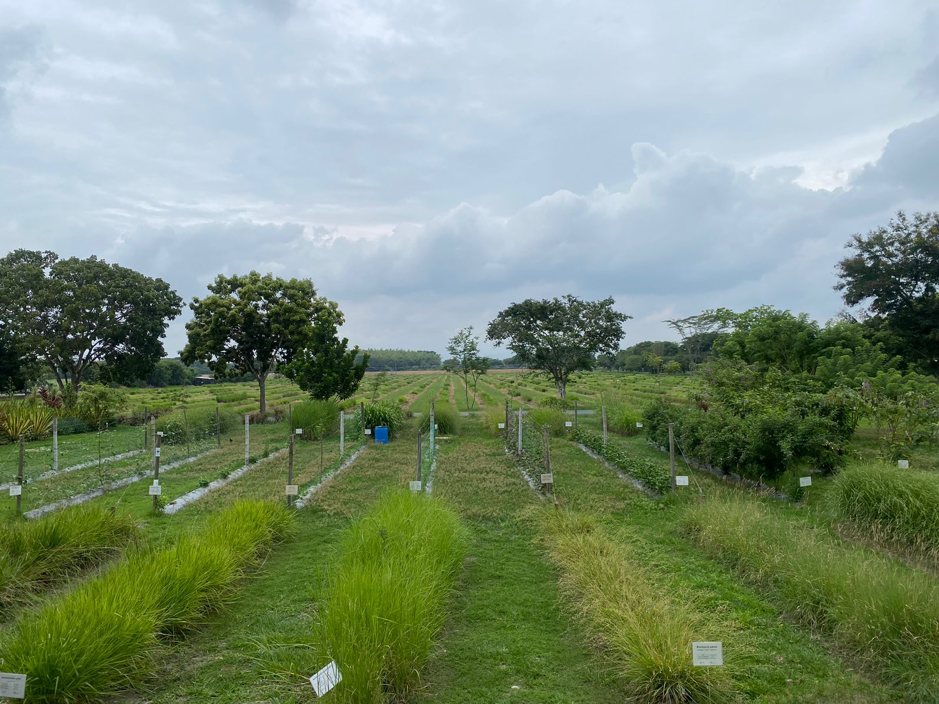A breath of fresh air and lush green fields, adorned with an array of dynamic plants exhibiting diverse biodiversity, welcomes visitors to the Alliance of Biodiversity International and the International Center for Tropical Agriculture (CIAT) in Colombia.
On the sidelines of COP 16 of the Convention on Biological Diversity, we visit the facility under the auspices of the Earth Journalism Network. Our first stop is at Future Seeds, described as a groundbreaking gene bank aimed at helping to climate-proof food systems. This initiative involves the conservation and distribution of genetic resources, innovation to improve those resources through various conservation methods, and raising awareness of the importance of crop genetic diversity, among other projects.

We are warmly welcomed by the staff, including Marcella Santaella, the Genebank Operations Manager at Alliance of Biodiversity International and CIAT, who states, “Future Seeds safeguards the world’s largest collections of beans, cassava, and tropical forages, comprising more than 67,000 different materials.”

As we walk through the quiet corridors, we see scientists and researchers keenly analysing various types of plants through different windows, working with the precision of surgeons to understand which genes contribute to adaptation under different climatic conditions.

Future Seeds, the first germplasm bank in the world to receive LEED (Leadership in Energy and Environmental Design) platinum certification, helps to conserve and distribute genetic resources of three of the most important crops for human and animal food globally. This initiative improves conservation methods and allows the public to learn about the significance of crop genetic diversity.
For instance, in the context of Africa, after the Rwandan genocide in 1994, which was precipitated by a civil war sparked by the death of the Rwandan president in a plane crash, approximately 800,000 people died, with another 2 million internally displaced or having fled to neighbouring countries. The most intense phase of the war occurred during the principal February to June growing season, lasting nearly four months, according to the SOH (Seeds of Hope) Review paper from 2004.

Marcella Santaella recounts how, during the genocide in Rwanda, thousands of farmers were forced to abandon their farms before harvest time. This not only endangered the food supply of the community but also threatened hundreds of traditional crops that nature and agriculture had selected over the centuries to withstand pests and local climate conditions.
“Seven research centers, including ours, got together to create an emergency plan to collect, multiply, and distribute samples of the 6 most important food crops in the country in order to restore agriculture and preserve genetic diversity. At GIAT, we achieved the repatriation of 260 varieties of beans from Palmira to Rwanda after only one year.” Says Marcella.
In Kenya, the facility assists with research through the International Livestock Research Institute and the World Agroforestry Centre.
We are later taken to one of the storage rooms, which is maintained at a temperature of -20 degrees Celsius, as each species requires specific conditions for its conservation. To preserve them indefinitely, it is necessary to control the temperature, light, oxygen, and humidity.

According to the facility, there are 37,936 samples of beans native to 107 countries, 5,957 samples of cassava native to 28 countries, and 22,657 samples of forages native to 111 countries. As of 2023, more than half a million samples of beans, forages, and cassava have been distributed to users from the National System of Research in Agriculture and Livestock, universities, farmers, research centres of the CGIAR, and others.
The facility also has biofortified crops, which are crops enriched with nutrients. In conjunction with 30 partners, it continues to promote cultivation and consumption in regions where maintaining a balanced diet is challenging. For instance, they have created fortified beans containing twice the amount of iron and zinc compared to regular beans, which are also more resistant to pests and diseases, leading to a reduction in pesticide use.
We later meet Jacobo Arango, a senior scientist at the facility, who elaborates on how, for decades, they have tested thousands of samples of different grasses and legumes and how this research can be used to reduce greenhouse gas emissions by capturing and storing carbon deep in the ground, depending on how deeply the roots penetrate the soil.

He shows us an anti-methanogenic feedstock for livestock systems and explains how promising forages that reduce emissions are evaluated using in vivo methodologies with respiration chambers. The project aims to identify and develop high-yielding, nutritious, and drought-tolerant forages that not only improve animal productivity but also decrease enteric methane (CH4) emissions through enrichment with certain plant compounds that exhibit anti-methanogenic properties.
By the time our tour ends at the Alliance of Biodiversity International and the International Centre for Tropical Agriculture (CIAT) in Colombia, it’s lunchtime, and we are invited to eat with the researchers and scientists at the facility, concluding our tour fully satisfied with both the lunch and the knowledge gained. It was a very insightful field trips thanks to the Earth Journalism Network.
(This story was produced as part of the 2024 CBD COP 16 Fellowship organised by Internews’ Earth Journalism Network.)





